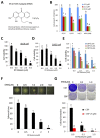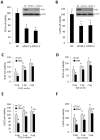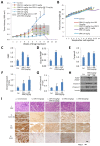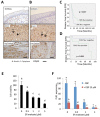ER maleate is a novel anticancer agent in oral cancer: implications for cancer therapy
- PMID: 26934445
- PMCID: PMC4941378
- DOI: 10.18632/oncotarget.7751
ER maleate is a novel anticancer agent in oral cancer: implications for cancer therapy
Abstract
ER maleate [10-(3-Aminopropyl)-3, 4-dimethyl-9(10H)-acridinone maleate] identified in a kinome screen was investigated as a novel anticancer agent for oral squamous cell carcinoma (OSCC). Our aim was to demonstrate its anticancer effects, identify putative molecular targets and determine their clinical relevance and investigate its chemosensitization potential for platinum drugs to aid in OSCC management. Biologic effects of ER maleate were determined using oral cancer cell lines in vitro and oral tumor xenografts in vivo. mRNA profiling, real time PCR and western blot revealed ER maleate modulated the expression of polo-like kinase 1 (PLK1) and spleen tyrosine kinase (Syk). Their clinical significance was determined in oral SCC patients by immunohistochemistry and correlated with prognosis by Kaplan-Meier survival and multivariate Cox regression analyses. ER maleate induced cell apoptosis, inhibited proliferation, colony formation, migration and invasion in oral cancer cells. Imagestream analysis revealed cell cycle arrest in G2/M phase and increased polyploidy, unravelling deregulation of cell division and cell death. Mechanistically, ER maleate decreased expression of PLK1 and Syk, induced cleavage of PARP, caspase9 and caspase3, and increased chemosensitivity to carboplatin; significantly suppressed tumor growth and increased antitumor activity of carboplatin in tumor xenografts. ER maleate treated tumor xenografts showed reduced PLK1 and Syk expression. Clinical investigations revealed overexpression of PLK1 and Syk in oral SCC patients that correlated with disease prognosis. Our in vitro and in vivo findings provide a strong rationale for pre-clinical efficacy of ER maleate as a novel anticancer agent and chemosensitizer of platinum drugs for OSCC.
Keywords: ER maleate; OSCC; Syk / PLK1; anticancer agent; tumor xenografts.
Conflict of interest statement
RR and PGW are shareholders in Proteocyte Diagnostics Inc., all the other coauthors declared no potential conflicts of interest.
Figures










Similar articles
-
Mutations of the LIM protein AJUBA mediate sensitivity of head and neck squamous cell carcinoma to treatment with cell-cycle inhibitors.Cancer Lett. 2017 Apr 28;392:71-82. doi: 10.1016/j.canlet.2017.01.024. Epub 2017 Jan 23. Cancer Lett. 2017. PMID: 28126323 Free PMC article.
-
Reciprocal activation between PLK1 and Stat3 contributes to survival and proliferation of esophageal cancer cells.Gastroenterology. 2012 Mar;142(3):521-530.e3. doi: 10.1053/j.gastro.2011.11.023. Epub 2011 Nov 19. Gastroenterology. 2012. PMID: 22108192
-
Polo-like kinase 1 inactivation enhances PI3K inhibition-mediated apoptosis of NOTCH1-mutant head and neck squamous cell carcinoma.Cancer Lett. 2025 Aug 10;625:217814. doi: 10.1016/j.canlet.2025.217814. Epub 2025 May 22. Cancer Lett. 2025. PMID: 40412794
-
Polo-like kinase inhibitors: an emerging opportunity for cancer therapeutics.Expert Opin Investig Drugs. 2010 Jan;19(1):27-43. doi: 10.1517/13543780903483191. Expert Opin Investig Drugs. 2010. PMID: 20001553 Review.
-
PLK1 inhibition in cancer therapy: potentials and challenges.Future Med Chem. 2019 Jun;11(12):1383-1386. doi: 10.4155/fmc-2019-0084. Epub 2019 Jul 12. Future Med Chem. 2019. PMID: 31298578 Review. No abstract available.
Cited by
-
Continuous flow synthesis of lipophilic cations derived from benzoic acid as new cytotoxic chemical entities in human head and neck carcinoma cell lines.RSC Med Chem. 2020 Aug 19;11(10):1210-1225. doi: 10.1039/d0md00153h. eCollection 2020 Oct 1. RSC Med Chem. 2020. PMID: 33479625 Free PMC article.
-
Deregulation of hsa_circ_0001971/miR-186 and hsa_circ_0001874/miR-296 signaling pathways promotes the proliferation of oral squamous carcinoma cells by synergistically activating SHP2/PLK1 signals.Sci Rep. 2021 Oct 18;11(1):20561. doi: 10.1038/s41598-021-99488-2. Sci Rep. 2021. PMID: 34663837 Free PMC article.
-
Low expression of miR-30a-5p induced the proliferation and invasion of oral cancer via promoting the expression of FAP.Biosci Rep. 2018 Jan 25;38(1):BSR20171027. doi: 10.1042/BSR20171027. Print 2018 Feb 28. Biosci Rep. 2018. Retraction in: Biosci Rep. 2024 Nov 27;44(11):BSR-2017-1027_RET. doi: 10.1042/BSR-2017-1027_RET. PMID: 29026005 Free PMC article. Retracted.
-
Prognostic value of spleen tyrosine kinase in human solid tumors.Onco Targets Ther. 2018 Jun 8;11:3377-3384. doi: 10.2147/OTT.S163136. eCollection 2018. Onco Targets Ther. 2018. PMID: 29922076 Free PMC article.
-
Targeted Treatment of Head and Neck (Pre)Cancer: Preclinical Target Identification and Development of Novel Therapeutic Applications.Cancers (Basel). 2021 Jun 3;13(11):2774. doi: 10.3390/cancers13112774. Cancers (Basel). 2021. PMID: 34204886 Free PMC article. Review.
References
-
- Ferlay J, Soerjomataram I, Dikshit R, Eser S, Mathers C, Rebelo M, Parkin DM, Forman D, Bray F. Cancer incidence and mortality worldwide: sources, methods and major patterns in GLOBOCAN 2012. Int J Cancer. 2015;136:E359–386. - PubMed
-
- Scully C, Bagan JV. Recent advances in Oral Oncology 2007: imaging, treatment and treatment outcomes. Oral Oncol. 2008;44:211–215. - PubMed
-
- Audrey RCB. Head and Neck: Squamous cell carcinoma: an overview. Atlas Genet Cytogenet Oncol Haematol. 2012;16:145–155.
MeSH terms
Substances
LinkOut - more resources
Full Text Sources
Other Literature Sources
Medical
Research Materials
Miscellaneous

